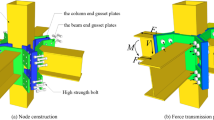Abstract
The support technology of temporary slope engineering such as building foundation pit, has the problems of small anchorage force, non-recyclable and excessive length of anchor. Focusing on these issues, this study puts forward a new support structure system named as inflatable controlled anchor. This new type of anchor was designed and manufactured for field test. To investigate the performance of the proposed anchor, a series of full-scale field model tests were carried out with the variables of inflation pressure, anchorage length, embedment depth, and steel strip thickness. The results show that the bearing capacity of inflatable controlled anchor mainly depends on the friction resistance between the steel strips and the hole wall. The rubber membrane as an independent part only provides the compressive pressing to steel strips, and the bearing capacity can be greatly improved by increasing the inflation pressure. The bearing capacity of the anchor is also improved by the increasing of anchorage length and embedment depth. If the thickness of the steel strips is too thin, the steel strip has obvious bending deformation under inflation pressure, which affects the anchoring effect, so the thickness of steel strip has a critical value of 5 mm. According to the experimental results, the working mechanism of inflatable controlled anchor is discussed, and the calculation method for the bearing capacity is proposed. The calculated values of the proposed formula are basically consistent with the experimental results, which verifies the correctness of the formula for forecasting the bearing capacity of inflatable controlled anchor.


















Similar content being viewed by others
Data Availability
The data used to support the findings of this study are included within the article.
References
Cao J, Peng Z, Peng W (2011) Experimental study on mechanical characteristics of inflatable anchors in soft clay. Chin J Geotech Eng 33(9):1399–1404 (in Chinese)
Cui X, He W (2013) Analysis of the anchorage segment under pullout for end expanding anchor. China Sciencepap 8(5):381–384
Dong J, Yuan F, Dong X (2017) Mechanical behaviors and analysis of a new supporting structure of deep foundation pit. China Civ Eng J 50(10):99–110 (in Chinese)
He R, Zhang P, Li N (2006) Working mechanism of fully grouted bolt inpull-out working state. J Cent South Univ Sci Technol 37(2):401–407 (in Chinese)
Hu Y (2017) Development of an inflatable expansive soil anchor and study of its performance. Master's Degree Thesis. Yangtze University, China
Liang Y, Hinchberger SD, Newson TA (2009) Non-linear analysis of pullout tests on inflatable anchors in sand. In: Proceedings of the Canadian geotechnical conference. Halifax, pp 1–8
Newson TA, Smith FW, Brunning P et al (2003a) An experimental study of inflatable offshore anchors. In: ISOPE 2003 conference. Honolulu, Hawaii, pp 127–135
Newson TA, Smith FW, Brunning P (2003b) An experimental study of inflatable offshore anchors in soft clays. In: ICOF2003, BGA conference on foundations. Dundee, pp 695–704
Newson T, Hinchberger S, Liang Y (2007) A numerical study of an inflatable anchor system. In: The 60th Canadian geotechnical conference and 8th joint CGS/IAH-CNC groundwater conference. Ottawa, pp 1258–1265
Peng W, Wang Y, Cao J (2010) Formation and analysis of the numerical simulation element for the inflatable anchor. J Geotech Investig Surv 6:6–10 (in Chinese)
Vesic AS (1972) Expansion of csavities in infinite soil mass. J Geotech Eng ASCE 98(SM3):265–290
Yang X (2017) An inflatable expansive soil anchor: China. 106978805A
Yu HS (2000) Cavity expansion methods in geomechanics. Kluwer Academic, Dordrecht
Zeng Q, Yang X, Yang C (2010) Mechanical mechanism and calculation method of bit expanded anchor rods. Rock Soil Mech 31(5):1359–1366
Acknowledgements
The authors gratefully acknowledge the support of the Natural Science Foundation of China (Grant No. 51678066).
Funding
Natural Science Foundation of China (Grant No. 51678066).
Author information
Authors and Affiliations
Corresponding author
Ethics declarations
Conflicts of interest
There is no conflict of interests exists in this paper.
Additional information
Publisher's Note
Springer Nature remains neutral with regard to jurisdictional claims in published maps and institutional affiliations.
Rights and permissions
About this article
Cite this article
Yang, X., Jia, S., Wen, C. et al. Anchoring Mechanism and Bearing Characteristics of the Inflatable Controlled Anchor. Geotech Geol Eng 38, 2523–2537 (2020). https://doi.org/10.1007/s10706-019-01166-8
Received:
Accepted:
Published:
Issue Date:
DOI: https://doi.org/10.1007/s10706-019-01166-8




